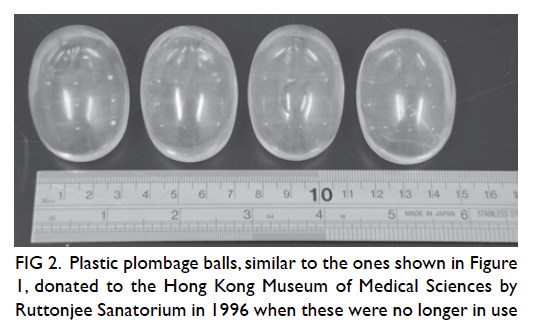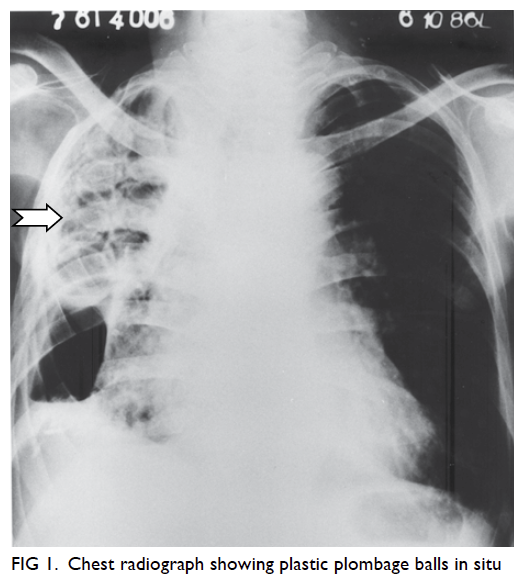Hong Kong Med J 2014;20:268 | Number 3, June 2014
© Hong Kong Academy of Medicine. CC BY-NC-ND 4.0
REMINISCENCE: ARTEFACTS FROM THE HKMMS
Plombage treatment for pulmonary tuberculosis in Hong Kong
TW Wong, FHKAM (Emergency Medicine)
Member, Education and Research Committee, Hong Kong Museum of Medical Sciences Society
Tuberculosis (TB) became a notifiable disease in
1939 in Hong Kong. In that year, 4443 deaths were
attributed to TB, which accounted for 9.2% of
all deaths. In short, TB was an important killer in
the early part of the 20th century. The state of TB
treatment in 1949, when the Columban Sisters began
their service in Hong Kong, was described as follows
by Sister Gabriel of Ruttonjee Sanatorium:
“In 1949 there were over 7,000 notifications and
2,600 deaths from TB in the Colony. TB was in
epidemic proportions, the highest incidence being
in children and young adults. Meningitis was rife
and many infants with miliary TB died of the
disease. There were no anti-TB drugs at this time;
the only treatment advised was good food, bed rest
and isolation of the infectious. BCG vaccination
did not come for another two years. Streptomycin
was the only medicine which could kill the bacilli
but it was not available in HK except for what was
confiscated at the China border. This could only be
used, under order from the medical department,
for children with meningitis or with miliary disease.
The management of patients being admitted was
not very encouraging.”1
Before the advent of anti-TB drugs, there was
no specific treatment for this infection. Surgical
treatment could be offered in some early cases. In
the 1930s, the three most commonly performed
operations were sectioning of the phrenic
nerve, creating an artificial pneumothorax, and
thoracoplasty by removing some ribs.2 The aims
of these operations were to collapse the part of the
lung harbouring the disease and, hopefully, halt
disease progression. The Annual Medical Report
of the government for the year 1934 reported that
the University Medical Unit at Government Civil
Hospital had started a special clinic for artificial
pneumothorax of pulmonary TB cases.
Plombage as a special form of collapse therapy
was introduced in the 1930s. This procedure entailed
placing some inert substance in the extrapleural
space to cause collapse of the lung. The X-ray shown
in Figure 1 shows the right upper lobe of the lung being collapsed by the use of plastic balls (Figure 2). Other inert substances like paraffin wax, oil, etc,
could also be used. However, complications including
haemorrhage, infection, and fistula formation
were not uncommon. Plombage treatment fell into
disfavour with the advent of anti-TB drugs in the
1950s.

Figure 2. Plastic plombage balls, similar to the ones shown in Figure 1, donated to the Hong Kong Museum of Medical Sciences by Ruttonjee Sanatorium in 1996 when these were no longer in use
References
1. O’Mahoney MG. A time of transition. Columban Sisters 2005: 11.
2. Li SF. Indications contraindications and end results in the surgical treatment of pulmonary TB. Caduceus
1931;10:167-77.


